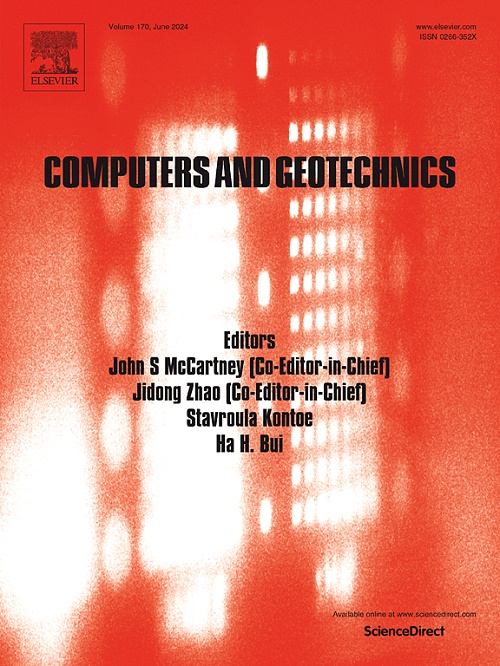Micropolar hypoplasticity modeling of localized deformation in mixtures of face mask chips and sand
IF 5.3
1区 工程技术
Q1 COMPUTER SCIENCE, INTERDISCIPLINARY APPLICATIONS
引用次数: 0
Abstract
This paper presents a novel micropolar-based hypoplastic model to reproduce the stress–strain relationship of face mask chips-sand mixtures (MSMs) and their localized deformation. Based on a critical state hypoplastic model, a non-polar hypoplastic model for MSMs is first developed with modifications and new features: (1) the cohesion induced by face mask chips is considered by introducing an additional stress tensor into the Cauchy stress tensor; (2) the initial stiffness variation in MSMs is described with a modified tangential modulus; and (3) the effective skeleton void ratio concept is introduced to capture the initial and critical void ratio variations in MSMs. The model is then extended to its micropolar terms by incorporating the micropolar theory, which includes an internal length parameter and a couple stress induced by particle rotation, with the advantage of overcoming the mesh dependency problem in the conventional finite element method (FEM) based simulations. Moreover, the new micropolar hypoplastic formulations are implemented into a FEM code. The onset and evolution of shear bands in MSMs are investigated by simulating a series of biaxial tests on both pure sand and MSMs. Numerical results are also compared to experimental observations, demonstrating that the developed micropolar hypoplastic model can adeptly capture the shear band propagation in MSMs and their mechanical responses.
求助全文
约1分钟内获得全文
求助全文
来源期刊

Computers and Geotechnics
地学-地球科学综合
CiteScore
9.10
自引率
15.10%
发文量
438
审稿时长
45 days
期刊介绍:
The use of computers is firmly established in geotechnical engineering and continues to grow rapidly in both engineering practice and academe. The development of advanced numerical techniques and constitutive modeling, in conjunction with rapid developments in computer hardware, enables problems to be tackled that were unthinkable even a few years ago. Computers and Geotechnics provides an up-to-date reference for engineers and researchers engaged in computer aided analysis and research in geotechnical engineering. The journal is intended for an expeditious dissemination of advanced computer applications across a broad range of geotechnical topics. Contributions on advances in numerical algorithms, computer implementation of new constitutive models and probabilistic methods are especially encouraged.
 求助内容:
求助内容: 应助结果提醒方式:
应助结果提醒方式:


